MERCURY

Mercury is the closest planet to the Sun and the eighth largest. Mercury is slightly smaller in diameter than the moons Ganymede and Titan but more than twice as massive.
Orbit from Sun: 57,910,000 km (0.38 AU)
Orbital period: 87.969 days (0.240846 yr)
Average orbital speed: 47.87 km/s
Diameter: 4,880 km
Mass: 3.30e23 kg
Equatorial surface gravity: 3.7 m/s² 0.38 g
Surface temp min 80 K, max 700 K
Sidereal rotation period: 58.646 day (1407.5 h)
Equatorial rotation velocity: 10.892 km/h (3.026 m/s)
Mercury has no satellites.
VENUS
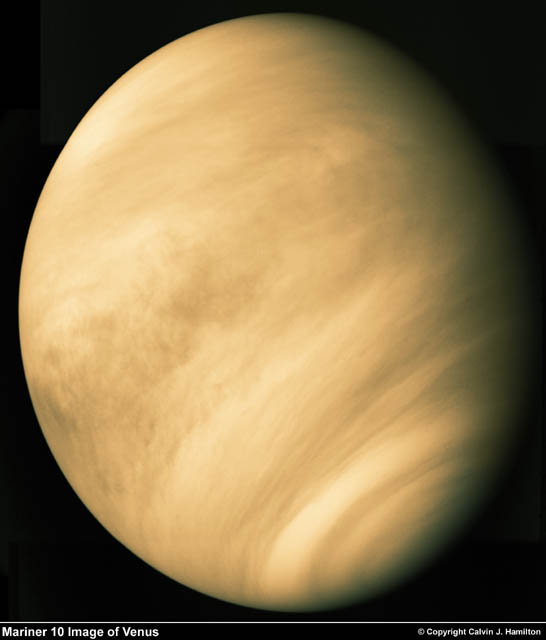
Venus is the second planet from the Sun and the sixth largest. Venus' orbit is the most nearly circular of that of any planet, with an eccentricity of less than 1%.
Orbit from Sun: 108,200,000 km (0.72 AU)
Orbital period: 224.70069 days (0.6151970 yr)
Average orbital speed: 35.02 km/s
Diameter: 12,103.6 km
Mass: 4.869e24 kg
Equatorial surface gravity: 8.87 m/s² 0.904 g
Surface temp: mean 735 K (461.85 °C)
Sidereal rotation period: 243.0185 day
Equatorial rotation velocity: 6.52 km/h (1.81 m/s)
Venus has no satellites.
Venus is sometimes regarded as Earth's sister planet. In some ways they are very similar:
• Venus is only slightly smaller than Earth (95% of Earth's diameter, 80% of Earth's mass).
• Both have few craters indicating relatively young surfaces.
• Their densities and chemical compositions are similar.
EARTH
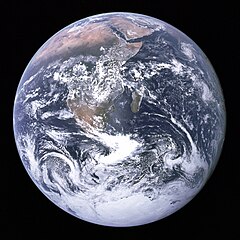
Earth is the third planet from the Sun and the fifth largest
Orbit from Sun: 149,600,000 km (1.00 AU)
Orbital period: 365.256366 days (1.0000175 yr)
Average orbital speed: 29.783 km/s (107218 km/h)
Diameter: 12,756.3 km
Mass: 5.972e24 kg
Equatorial surface gravity: 9.81 m/s² 0.997 g
Surface temp: mean 287 K (14 °C)
Sidereal rotation period: 0.99726968 day
Equatorial rotation velocity: 1674.4 km/h (465.1 m/s)
Earth has only one natural satellite, the Moon.

Moon (radius: 1738 km, mass: 7.35e22 kg, orbit from earth: 384000 km)

A scale representation of the relative sizes of, and distance between, Earth and Moon.
Distance Radius Mass Satellite (000 km) (km) (kg) --------- -------- ------ ------- Moon 384 1738 7.35e22
MARS
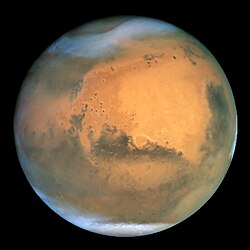
Mars is the fourth planet from the Sun and the seventh largest
Orbit from Sun: 227,940,000 km (1.52 AU)
Orbital period: 686.971 days (1.8808 yr)
Average orbital speed: 24.077 km/s
Diameter: 6,794 km
Mass: 6.4219e23 kg
Equatorial surface gravity: 3.68 m/s² 0.375 g
Surface temp: mean 227 K (-46 °C)
Sidereal rotation period: 1.025957 day (24.62296 h)
Equatorial rotation velocity: 868.22 km/h (241.17 m/s)
Mars has two tiny satellites which orbit very close to the martian surface.
Distance Radius Mass Satellite (000 km) (km) (kg) Discoverer Date --------- -------- ------ ------- ---------- ---- Phobos 9 11 1.08e16 Hall 1877 Deimos 23 6 1.80e15 Hall 1877

Phobos (radius: 11 km, mass: 1.08e16 kg, orbit from Mars: 9000 km)

Deimos (radius: 6 km, mass: 1.80e15 kg, orbit from Mars: 23000 km)
JUPITER

Jupiter is the fifth planet from the Sun and by far the largest. Jupiter is more than twice as massive as all the other planets combined (the mass of Jupiter is 318 times that of Earth).
Orbit from Sun: 778,330,000 km (5.20 AU)
Orbital period: 4331.572 days (11.85920 yr)
Average orbital speed: 13.07 km/s
Diameter: 142,984 km (equatorial)
Mass: 1.900e27 kg
Equatorial surface gravity: 24.79 m/s² 2.528 g
Surface temp: mean 163 K
Sidereal rotation period: 9.925 h
Equatorial rotation velocity: 45300 km/h (12.6 km/s)
Jupiter is about 90% hydrogen and 10% helium (by numbers of atoms, 75/25% by mass) with traces of methane, water, ammonia and "rock". This is very close to the composition of the primordial Solar Nebula from which the entire solar system was formed.
Jupiter has rings like Saturn's, but much fainter and smaller. They were totally unexpected and were only discovered when two of the Voyager 1 scientists insisted that after traveling 1 billion km it was at least worth a quick look to see if any rings might be present. Everyone else thought that the chance of finding anything was nil, but there they were. It was a major coup. They have since been imaged in the infra-red from ground-based observatories and by Galileo.

Distance Width Mass Ring (km) (km) (kg) ---- -------- ----- ------ Halo 100000 22800 ? Main 122800 6400 1e13 Gossamer 129200 214200 ?Jupiter has 63 known satellites. Io, Europa and Ganymede are locked together in a 1:2:4 orbital resonance and their orbits evolve together. Callisto is almost part of this as well. In a few hundred million years, Callisto will be locked in too, orbiting at exactly twice the period of Ganymede (eight times the period of Io)
Distance Radius Mass Satellite (000 km) (km) (kg) Discoverer Date --------- -------- ------ ------- ---------- ----- Metis 128 20 9.56e16 Synnott 1979 Adrastea 129 10 1.91e16 Jewitt 1979 Amalthea 181 98 7.17e18 Barnard 1892 Thebe 222 50 7.77e17 Synnott 1979 Io 422 1815 8.94e22 Galileo 1610 Europa 671 1569 4.80e22 Galileo 1610 Ganymede 1070 2631 1.48e23 Galileo 1610 Callisto 1883 2400 1.08e23 Galileo 1610 Leda 11094 8 5.68e15 Kowal 1974 Himalia 11480 93 9.56e18 Perrine 1904 Lysithea 11720 18 7.77e16 Nicholson 1938 Elara 11737 38 7.77e17 Perrine 1905 Ananke 21200 15 3.82e16 Nicholson 1951 Carme 22600 20 9.56e16 Nicholson 1938 Pasiphae 23500 25 1.91e17 Melotte 1908 Sinope 23700 18 7.77e16 Nicholson 1914

Io (radius: 1815 km, mass: 8.94e22 kg, orbit from Jupiter: 422000 km)

Europa (radius: 1569 km, mass: 4.80e22 kg, orbit from Jupiter: 671000 km)
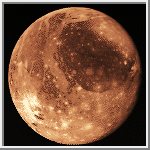
Ganymede (radius: 2631 km, mass: 1.48e23 kg, orbit from Jupiter: 1070000 km)
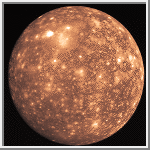
Callisto (radius: 2400 km, mass: 1.08e23 kg, orbit from Jupiter: 1883000 km)
SATURN

Saturn is the sixth planet from the Sun and the second largest
Orbit from Sun: 1,429,400,000 km (9.54 AU)
Orbital period: 10759.22 days (29.4571 yr)
Average orbital speed: 9.69 km/s
Diameter: 120,536 km (equatorial)
Mass: 5.68e26 kg
Equatorial surface gravity: 8.96 m/s² 0.914 g
Surface temp: mean 134 K
Sidereal rotation period: 0.439 – 0.449 day (10 h 32 min– 10 h 47 min)
Equatorial rotation velocity: 9.87 km/s (35 500 km/h)
Like Jupiter, Saturn is about 75% hydrogen and 25% helium with traces of water, methane, ammonia and "rock".
Saturn has a prominent system of rings, consisting mostly of ice particles with a smaller amount of rocky debris and dust. Sixty-one known moons orbit the planet, not counting hundreds of "moonlets" within the rings. Titan, Saturn's largest and the Solar System's second largest moon (after Jupiter's Ganymede), is larger than the planet Mercury and is the only moon in the Solar System to possess a significant atmosphere.
Radius Radius approx. approx. Name inner outer width position mass (kg) ---- ------ ------ ----- -------- -------- D-Ring 67,000 74,500 7,500 (ring) Guerin Division C-Ring 74,500 92,000 17,500 (ring) 1.1e18 Maxwell Division 87,500 88,000 500 (divide) B-Ring 92,000 117,500 25,500 (ring) 2.8e19 Cassini Division 115,800 120,600 4,800 (divide) Huygens Gap 117,680 (n/a) 285-440 (subdiv) A-Ring 122,200 136,800 14,600 (ring) 6.2e18 Encke Minima 126,430 129,940 3,500 29%-53% Encke Division 133,410 133,740 Keeler Gap 136,510 136,550 F-Ring 140,210 30-500 (ring) G-Ring 165,800 173,800 8,000 (ring) 1e7? E-Ring 180,000 480,000 300,000 (ring)Saturn has 34 named satellite. Of those moons for which rotation rates are known, all but Phoebe and Hyperion rotate synchronously.
Distance Radius Mass Satellite (000 km) (km) (kg) Discoverer Date --------- -------- ------ ------- ---------- ----- Pan 134 10 ? Showalter 1990 Atlas 138 14 ? Terrile 1980 Prometheus 139 46 2.70e17 Collins 1980 Pandora 142 46 2.20e17 Collins 1980 Epimetheus 151 57 5.60e17 Walker 1980 Janus 151 89 2.01e18 Dollfus 1966 Mimas 186 196 3.80e19 Herschel 1789 Enceladus 238 260 8.40e19 Herschel 1789 Tethys 295 530 7.55e20 Cassini 1684 Telesto 295 15 ? Reitsema 1980 Calypso 295 13 ? Pascu 1980 Dione 377 560 1.05e21 Cassini 1684 Helene 377 16 ? Laques 1980 Rhea 527 765 2.49e21 Cassini 1672 Titan 1222 2575 1.35e23 Huygens 1655 Hyperion 1481 143 1.77e19 Bond 1848 Iapetus 3561 730 1.88e21 Cassini 1671 Phoebe 12952 110 4.00e18 Pickering 1898


Saturn Ring Structure (Pic from : http://www2.jpl.nasa.gov)
The three pairs Mimas-Tethys, Enceladus-Dione and Titan-Hyperion interact gravitationally in such a way as to maintain stable relationships between their orbits: the period of Mimas' orbit is exactly half that of Tethys, they are thus said to be in a 1:2 resonance; Enceladus-Dione are also 1:2; Titan-Hyperion are in a 3:4 resonance.
URANUS
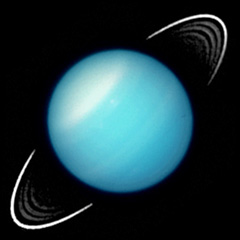
Uranus is the seventh planet from the Sun and the third largest (by diameter). Uranus is larger in diameter but smaller in mass than Neptune.
Orbit: 2,870,990,000 km (19.218 AU) from Sun
Orbital period: 30799.095 days
Average orbital speed: 6.81 km/s
Diameter: 51,118 km (equatorial)
Mass: 8.683e25 kg
Equatorial surface gravity: 8.69 m/s² 0.886 g
Surface temp: mean 76 K
Sidereal rotation period: -0.71833 day (17 h 14 min 24 s)
Equatorial rotation velocity: 2.59 km/s (9320 km/h)
Uranus's axis of rotation lies on its side with respect to the plane of the Solar System, with an axial tilt of 97.77 degrees. This gives it seasonal changes completely unlike those of the other major planets. Other planets can be visualized to rotate like tilted spinning tops relative to the plane of the solar system, while Uranus rotates more like a tilted rolling ball. Near the time of Uranian solstices, one pole faces the Sun continuously while the other pole faces away.
Uranus is composed primarily of rock and various ices, with only about 15% hydrogen and a little helium (in contrast to Jupiter and Saturn which are mostly hydrogen). Uranus (and Neptune) are in many ways similar to the cores of Jupiter and Saturn minus the massive liquid metallic hydrogen envelope. It appears that Uranus does not have a rocky core like Jupiter and Saturn but rather that its material is more or less uniformly distributed.
Uranus' atmosphere is about 83% hydrogen, 15% helium and 2% methane.
Uranus has rings. Like Jupiter's, they are very dark but like Saturn's they are composed of fairly large particles ranging up to 10 meters in diameter in addition to fine dust. There are 11 known rings, all very faint; the brightest is known as the Epsilon ring. The Uranian rings were the first after Saturn's to be discovered. This was of considerable importance since we now know that rings are a common feature of planets, not a peculiarity of Saturn alone.

Distance Width Ring (km) (km) ------- -------- ----- 1986U2R 38000 2,500 6 41840 1-3 5 42230 2-3 4 42580 2-3 Alpha 44720 7-12 Beta 45670 7-12 Eta 47190 0-2 Gamma 47630 1-4 Delta 48290 3-9 1986U1R 50020 1-2 Epsilon 51140 20-100Uranus has 21 named moons and six unnamed ones
Distance Radius Mass Satellite (000 km) (km) (kg) Discoverer Date --------- -------- ------ ------- ---------- ----- Cordelia 50 13 ? Voyager 2 1986 Ophelia 54 16 ? Voyager 2 1986 Bianca 59 22 ? Voyager 2 1986 Cressida 62 33 ? Voyager 2 1986 Desdemona 63 29 ? Voyager 2 1986 Juliet 64 42 ? Voyager 2 1986 Portia 66 55 ? Voyager 2 1986 Rosalind 70 27 ? Voyager 2 1986 Cupid 75 6 ? Showalter 2003 Belinda 75 34 ? Voyager 2 1986 Perdita 76 40 ? Voyager 2 1986 Puck 86 77 ? Voyager 2 1985 Mab 98 8 ? Showalter 2003 Miranda 130 236 6.30e19 Kuiper 1948 Ariel 191 579 1.27e21 Lassell 1851 Umbriel 266 585 1.27e21 Lassell 1851 Titania 436 789 3.49e21 Herschel 1787 Oberon 583 761 3.03e21 Herschel 1787 Francisco 4281 6 ? Sheppard 2003 Caliban 7169 40 ? Gladman 1997 Stephano 7948 15 ? Gladman 1999 Trinculo 8578 5 ? Holman 2001 Sycorax 12213 80 ? Nicholson 1997 Margaret 14689 6 ? Sheppard 2003 Prospero 16568 20 ? Holman 1999 Setebos 17681 20 ? Kavelaars 1999 Ferinand 21000 6 ? Sheppard 2003

They form three distinct classes: the 11 small very dark inner ones discovered by Voyager 2, the 5 large ones (right), and the newly discovered much more distant ones. Most have nearly circular orbits in the plane of Uranus' equator (and hence at a large angle to the plane of the ecliptic); the outer 4 are much more elliptical.
NEPTUNE
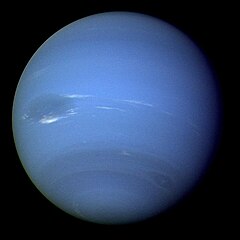
Neptune is the eighth planet from the Sun and the fourth largest (by diameter). Neptune is smaller in diameter but larger in mass than Uranus.
Orbit from Sun: 4,504,000,000 km (30.06 AU)
Orbital period: 164.79 years
Average orbital speed: 5.43 km/s
Diameter: 49,532 km (equatorial)
Mass: 1.0247e26 kg
Equatorial surface gravity: 11.15 m/s² 1.14 g
Surface temp: mean 72 K
Sidereal rotation period: 0.6713 day (16 h 6 min 36 s)
Equatorial rotation velocity: 2.68 km/h (9660 km/s)
Neptune's composition is probably similar to Uranus': various "ices" and rock with about 15% hydrogen and a little helium. Like Uranus, but unlike Jupiter and Saturn, it may not have a distinct internal layering but rather to be more or less uniform in composition. But there is most likely a small core (about the mass of the Earth) of rocky material. Its atmosphere is mostly hydrogen and helium with a small amount of methane.
Neptune's blue color is largely the result of absorption of red light by methane in the atmosphere but there is some additional as-yet-unidentified chromophore which gives the clouds their rich blue tint.
Neptune also has rings. Earth-based observations showed only faint arcs instead of complete rings, but Voyager 2's images showed them to be complete rings with bright clumps. One of the rings appears to have a curious twisted structure.
Distance Width Ring (km) (km) aka ------- -------- ----- ------- Diffuse 41900 15 1989N3R, Galle Inner 53200 15 1989N2R, LeVerrier Plateau 53200 5800 1989N4R, Lassell, Arago Main 62930 < 50 1989N1R, Adams

Neptune has 13 known moons.
Distance Radius Mass Satellite (000 km) (km) (kg) Discoverer Date --------- -------- ------ ------- ---------- ----- Naiad 48 29 ? Voyager 2 1989 Thalassa 50 40 ? Voyager 2 1989 Despina 53 74 ? Voyager 2 1989 Galatea 62 79 ? Voyager 2 1989 Larissa 74 96 ? Voyager 2 1989 Proteus 118 209 ? Voyager 2 1989 Triton 355 1350 2.14e22 Lassell 1846 Nereid 5509 170 ? Kuiper 1949
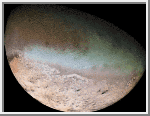
Triton (radius: 355000 km, mass: 2.14e22 kg)
No comments:
Post a Comment
Note: Only a member of this blog may post a comment.